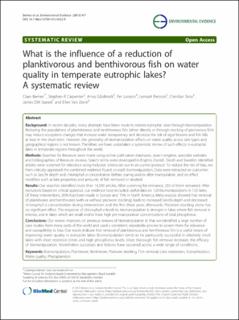| dc.contributor.author | Bernes, Claes | |
| dc.contributor.author | Carpenter, Stephen R. | |
| dc.contributor.author | Gårdmark, Anna | |
| dc.contributor.author | Larsson, Per | |
| dc.contributor.author | Persson, Lennart | |
| dc.contributor.author | Skov, Christian | |
| dc.contributor.author | Speed, James David Mervyn | |
| dc.contributor.author | van Donk, Ellen | |
| dc.date.accessioned | 2020-06-12T07:12:19Z | |
| dc.date.available | 2020-06-12T07:12:19Z | |
| dc.date.created | 2016-01-06T12:03:09Z | |
| dc.date.issued | 2015 | |
| dc.identifier.citation | Environmental Evidence. 2015, 4:7 . | en_US |
| dc.identifier.issn | 2047-2382 | |
| dc.identifier.uri | https://hdl.handle.net/11250/2657808 | |
| dc.description.abstract | Background:In recent decades, many attempts have been made to restore eutrophic lakes through biomanipulation.Reducing the populations of planktivorous and benthivorous fish (either directly or through stocking of piscivorous fish)may induce ecosystem changes that increase water transparency and decrease the risk of algal blooms and fish kills,at least in the short term. However, the generality of biomanipulation effects on water quality across lake types andgeographical regions is not known. Therefore, we have undertaken a systematic review of such effects in eutrophiclakes in temperate regions throughout the world.Methods:Searches for literature were made using online publication databases, search engines, specialist websitesand bibliographies of literature reviews. Search terms were developed in English, Danish, Dutch and Swedish. Identifiedarticles were screened for relevance using inclusion criteria set out in anaprioriprotocol. To reduce the risk of bias, wethen critically appraised the combined evidence found on each biomanipulation. Data were extracted on outcomessuch as Secchi depth and chlorophyllaconcentration before, during and/or after manipulation, and on effectmodifiers such as lake properties and amounts of fish removed or stocked.Results:Our searches identified more than 14,500 articles. After screening for relevance, 233 of them remained. Afterexclusions based on critical appraisal, our evidence base included useful data on 128 biomanipulations in 123 lakes.Of these interventions, 85% had been made in Europe and 15% in North America. Meta-analysis showed that removalof planktivores and benthivores (with or without piscivore stocking) leads to increased Secchi depth and decreasedchlorophyllaconcentration during intervention and the first three years afterwards. Piscivore stocking alone hasno significant effect. The response of chlorophyllalevels to biomanipulation is stronger in lakes where fish removal isintense, and in lakes which are small and/or have high pre-manipulation concentrations of total phosphorus.Conclusions:Our review improves on previous reviews of biomanipulation in that we identified a large number ofcase studies from many parts of the world and used a consistent, repeatable process to screen them for relevanceand susceptibility to bias. Our results indicate that removal of planktivorous and benthivorous fish is a useful means ofimproving water quality in eutrophic lakes. Biomanipulation tends to be particularly successful in relatively smalllakes with short retention times and high phosphorus levels. More thorough fish removal increases the efficacyof biomanipulation. Nonetheless successes and failures have occurred across a wide range of conditions. | en_US |
| dc.language.iso | eng | en_US |
| dc.publisher | BMC | en_US |
| dc.rights | Navngivelse 4.0 Internasjonal | * |
| dc.rights.uri | http://creativecommons.org/licenses/by/4.0/deed.no | * |
| dc.title | What is the influence of a reduction of planktivorous and benthivorous fish on water quality in temperate eutrophic lakes? A systematic review | en_US |
| dc.type | Peer reviewed | en_US |
| dc.type | Journal article | en_US |
| dc.description.version | publishedVersion | en_US |
| dc.source.pagenumber | 28 | en_US |
| dc.source.volume | 4:7 | en_US |
| dc.source.journal | Environmental Evidence | en_US |
| dc.identifier.doi | 10.1186/s13750-015-0032-9 | |
| dc.identifier.cristin | 1306923 | |
| dc.description.localcode | © 2015 Bernes et al.; licensee BioMed Central. This is an Open Access article distributed under the terms of the CreativeCommons Attribution License (http://creativecommons.org/licenses/by/4.0), which permits unrestricted use, distribution, andreproduction in any medium, provided the original work is properly credited. The Creative Commons Public DomainDedication waiver (http://creativecommons.org/publicdomain/zero/1.0/) applies to the data made available in this article,unless otherwise stated | en_US |
| cristin.ispublished | true | |
| cristin.fulltext | original | |
| cristin.qualitycode | 1 | |

